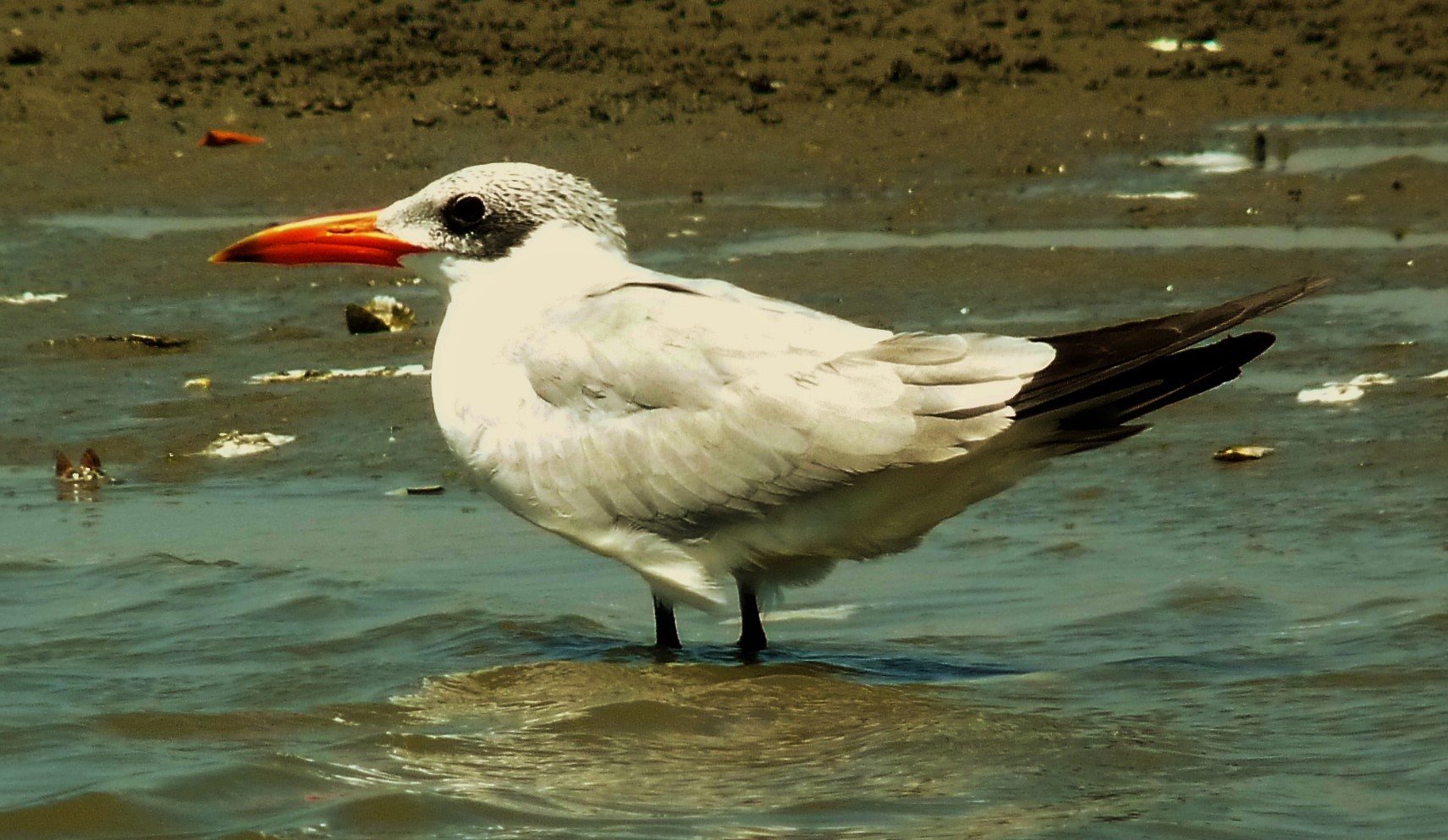Caspian Tern
A species of Caspian Tern Scientific name : Hydroprogne caspia Genus : Caspian Tern
Caspian Tern, A species of Caspian Tern
Botanical name: Hydroprogne caspia
Genus: Caspian Tern
Content
Description People often ask General Info
Description
It is the world's largest tern with a length of 48–60 cm (19–24 in), a wingspan of 127–145 cm (50–57 in) and a weight of 530–782 g (18.7–27.6 oz). Adult birds have black legs, and a long thick red-orange bill with a small black tip. They have a white head with a black cap and white neck, belly and tail. The upper wings and back are pale grey; the underwings are pale with dark primary feathers. In flight, the tail is less forked than other terns and wing tips black on the underside. In winter, the black cap is still present (unlike many other terns), but with some white streaking on the forehead. The call is a loud heron-like croak. 
Size
48 - 58 cm
Colors
Black
Gray
White
Life Expectancy
26 years
Nest Placement
Ground
Clutch Size
1 - 3 eggs
Incubation Period
1 brood
Number of Broods
25 - 28 days
Nestling Period
1 - 2 days
Feeding Habits
Caspian Tern's diet consists predominantly of fish, augmented by crustaceans, large insects, occasionally birds and rodents. They exhibit aerial dives for aquatic prey from heights up to 100 feet. Caspian Tern can travel 60 km to forage, utilizing fresh and marine waters. They also engage in kleptoparasitism and opportunistic scavenging.
Habitat
Caspian Tern occupy diverse habitats around the world, predominately near large lakes, coastal waters, and beaches. They nest in open areas with minimal vegetation, such as sandy or pebbly ground. These birds prefer habitats that enable easy predator spotting and often reside alongside other waterbirds. Adaptability allows them to utilize artificial environments like dredge-spoil islands. Throughout the year, caspian Tern choose habitats that provide accessible foraging opportunities, including freshwater bodies and estuaries, avoiding deep sea regions.
Nest Behavior
Caspian Tern engage in nest building cooperatively, selecting sites and creating scrapes. They exhibit egg-laying and tend to both eggs and progeny diligently, with specific nesting season timing depending on geographic location.
Nest Characteristics
The nests of caspian Tern are scrapes located in open, flat areas with minimal vegetation, typically composed of sand, shells, pebbles, gravel, or dirt. These are lined with dried vegetation and circled by pebbles or shells, measuring approximately 7.7 inches in diameter and 1.6 inches in height.
Dite type
Piscivorous
People often ask
General Info
Feeding Habits
Bird food type
Sounds
Call
Recording location: Mexico
Call
Recording location: United States
Behavior
Caspian Tern engage in distinct courtship rituals upon returning to their nesting areas. Males perform by catching fish and exhibiting them in flight to groups of other terns, a display aimed at attracting females. In pursuit of a mate, these males may be followed or chased by male and female caspian Tern alike. Successful males present their catch to a female alongside a series of nods. If receptive, the female may accept the fish with a juvenile-like display of nodding and calling, which can result in pairing. Interestingly, some caspian Tern may arrive to breeding grounds with a partner already chosen. Daily, caspian Tern are dynamic in their environment—fishing, courtship, and social interactions are core to their lifestyle.
Distribution Area
Their breeding habitat is large lakes and ocean coasts in North America (including the Great Lakes), and locally in Europe (mainly around the Baltic Sea and Black Sea), Asia, Africa, and Australasia (Australia and New Zealand). North American birds migrate to southern coasts, the West Indies and northernmost South America. European and Asian birds spend the non-breeding season in the Old World tropics. African and Australasian birds are resident or disperse over short distances. In 2016, a nest of the Caspian tern was found in the Cape Krusenstern National Monument in northwestern Alaska, 1,000 miles further north than any previous sighting. This development was part of a general trend in Alaska of species moving to the north, a tendency ascribed to global warming. The global population is about 50,000 pairs; numbers in most regions are stable, but the Baltic Sea population (1400–1475 pairs in the early 1990s) is declining and of conservation concern. The Caspian tern is one of the species to which the Agreement on the Conservation of African-Eurasian Migratory Waterbirds (AEWA) applies. 
Species Status
Not globally threatened.
